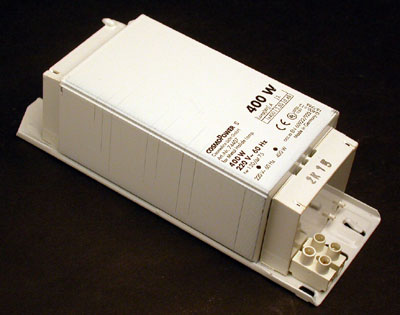A lighting ballast is a piece of equipment required to control the starting and operating voltages of electrical gas discharge lights. Examples of gas discharge light sources include fluorescent and neon lights and high-intensity discharge (HID) lamps. The term lighting ballast can refer to any component of the circuit intended to limit the flow of current through the light, from a single resistor to more complex devices.
A lighting ballast is necessary to operate discharge lights because they have negative resistance, meaning they are unable to regulate the amount of current that passes through them. A lighting ballast must be used to control current flow; otherwise the light could fail. Small light sources can use passive components, which require no additional power to operate, as ballasts. An example would be a series resistor that limits the flow of current across its terminals. For high-powered lights, however, a resistor would waste a large amount of electricity, so a more complex lighting ballast is required.
An
electromagnetic lighting ballast uses electromagnetic induction to provide the starting and operating voltages of a gas discharge light. Inside each is a coil of wire and an electromagnetic field that together transform voltage. Some also include an igniter for high-power applications.
Electromagnetic ballasts limit the flow of current to the light but do not change the frequency of the input power. The lamp then illuminates on each half-cycle of the power source. This is why many fluorescent and neon lights visibly flicker. Since the light illuminates on half-cycles, the rate of flicker is twice the frequency of the power source, meaning the light will flicker at 100Hz or 120Hz. A lead-lag lighting ballast can minimize flicker when connected to two lamps by alternating the flow of current to them: one leading the frequency of the input power and the other lagging behind it.

A more modern type of lighting ballast is electronic instead of electromagnetic. Electronic Ballast creating artificial light. The discovery of electric power and the possibility of transmitting it in a simple manner facilitated the development of modern lamps. Today there are nearly 6,000 different lamps being manufactured, most of which can be placed in the following six categories: incandescent, fluorescent, mercury vapor, metal halide, highpressure sodium (HPS) and low-pressure sodium (LPS). Except for incandescent lamps, all of these light sources can be termed as gas discharge lamps. Fluorescent and LPS lamps operate on low-pressure gaseous discharge, and the mercury vapor, metal halide and HPS lamps operate on high-pressure gaseous discharge. The mercury vapor, metal halide and HPS types are commonly known as high-intensity discharge (HID) lamps. The major characteristics to be considered when choosing a lamp are its luminous efficacy, life, lumen depreciation and color rendering. Luminous efficacy is the measure of the lamp’s ability to convert input electric power, in watts, into output luminous flux, in lumens, and is measured in lumens per watt (lm/w). The luminous flux of a light source is the electromagnetic radiation within the visible part of the electromagnetic spectrum multiplied by the sensitivity of man’s eyes to that part of the light from the source. The visible portion of the spectrum covers the wavelength range from approximately 380 nm to 780 nm (Figure 1). The life of a lamp is the number of hours it takes for approximately 50% of a large group of lamps of the same kind to fail. Failure means that the lamp will no longer light or that light output has dropped to a specific percentage value. Lumen depreciation during life is a characteristic of all lamps. An electronic lighting ballast uses solid state circuitry to transform voltage, but unlike electromagnetic ballasts, can also alter the frequency of power. This means that an electronic lighting ballast can greatly reduce or eliminate any flicker in the lamps. Because it uses solid-state circuitry instead of magnetic coils, it is also more efficient and therefore runs cooler.

Because of their greater efficiency and ability to reduce flicker, electronic ballasts are more popular than
electromagnetic ballasts, and are often used to replace them. A few applications, however, require an electromagnetic lighting ballast, such as ballasts that must preheat or ballasts for extremely high output lamps.

